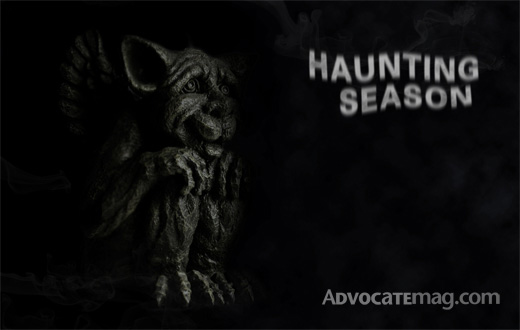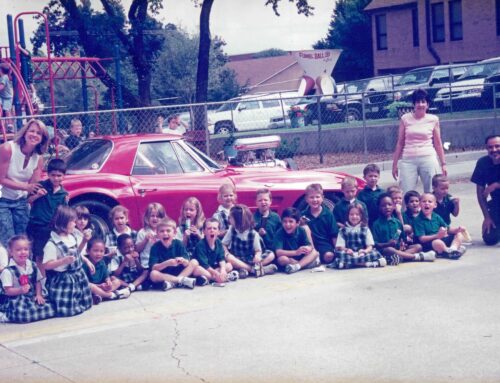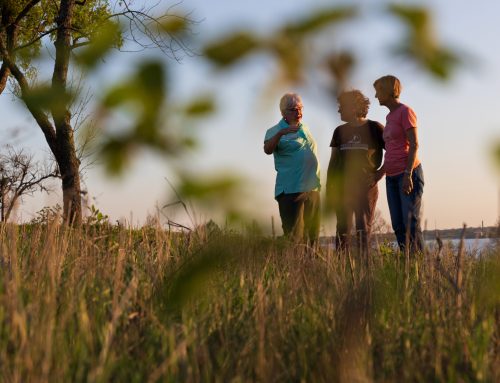Underneath what looks, on the surface, like a near-utopian area — where chatty mommies push strollers, high school students toss footballs and cyclists traverse freshly paved trail — lurks mystery, a dark history and an unseen menace.
What you read here might change the way you perceive our neighborhood, by way of exploring some of its mysteries and lore.
Cox Cemetery on Dalgreen Road
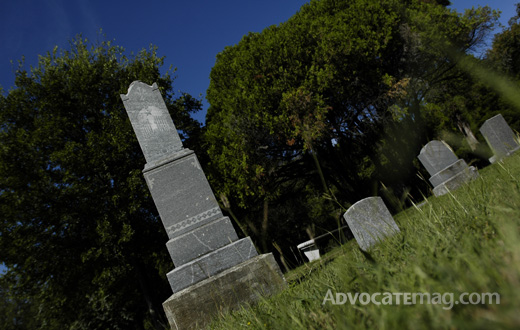
Cox Cemetery is the burial place of neighborhood pioneers, and it has been the site of many high school shenanigans.
The old cemetery at White Rock Lake dates to the mid-1840s, and its tombstones bear the names of our neighborhood’s pioneers: McCommas, Fisher, Glover, Lavender.
Among Woodrow Wilson High School alumni, it is known as a haunted cemetery and the site of much hijinks.
To initiate freshman band members, for example, upperclassmen would blindfold them, take them to Cox Cemetery, and then leave them there at night.
“That was kind of a rite of passage,” says Woodrow alumnus Kyle Rains.
Although it’s rumored the cemetery is haunted, we couldn’t find anyone who claims to have seen ghosts there.
But abandoning one’s friends in the cemetery to scare the wits out of them was common among high school students in the ’70s.
Lisa Cavanaugh, a 1979 Woodrow graduate who is now a teacher at J.L. Long Middle School, recalls such a story “back in the late ’70s, when cell phones were not around.”
After a football game one night, she and her friend went driving around with some guy friends. They had filled up on Cokes at a pizza place, and before long, the girls were feeling the effects. Finally, the guys stopped and let them out to relieve themselves in the dark near White Rock Lake.
“Unbeknown to us, the guys chose Cox Cemetery to drop us off, and boy did they drop us — they drove off,” she says. “Screaming didn’t do any good. It just scared us all the more.”
After about 30 minutes in the pitch-black cemetery, the guys reappeared.
Cavanaugh ran into one of those guys recently, and she reminded him of the prank, admonishing him with, “How would you like it if someone did that to your daughter now?”
He gave her a woeful apology, she says.
Rains says Woodrow/Bryan Adams high school rivalries played out at the cemetery too.
“They used to come over to our side of the lake to explore, and we didn’t like that, so we used to hide behind the tombstones and wait for them,” he says.
“Once, my friend Ricky Rodriguez and I scared a B.A. guy so much, he hurdled the fence.”
Cox Cemetery is not open to the public, but it usually is unlocked.
The many mysteries of White Rock Lake
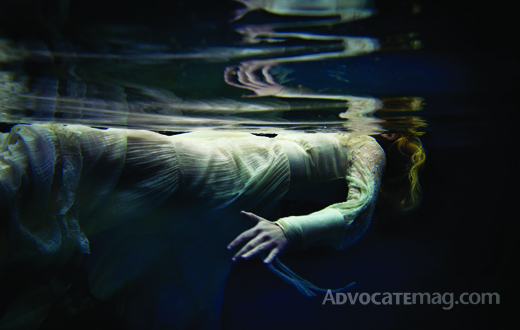
Photographer Kathleen Wilke’s Lady of the Lake series captures the ethereal beauty of White Rock’s cherished ghost story. The model is Woodrow Wilson High School alumna Katie Shank.
Residents of the White Rock area keep the Lady of the Lake legend alive: After the sun sets and the traffic dwindles, a figure in flowing white supposedly roams the lake’s fringes looking for a ride, they say. Rumors abound of sightings and close encounters in which the eerie lady hops in a car only to disappear — leaving behind a puddle — before arriving at her requested destination, usually a home on Gaston Avenue or in Forest Hills.
Joy Maner, director of research at the Association for the Study of Unexplained Phenomenon, led a study on the hauntings of White Rock Lake. She says White Rock Lake’s “rather deadly” history makes it ripe for hauntings and urban legend. Maner believes the 1927 death of 19-year-old Hallie Gaston spurred the Lady of the Lake lore. Hallie died in a boating accident near Big Thicket, she says.
“I personally believe this started the legend among young people in Dallas early on,” Maner says.
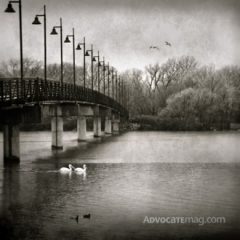
Photographer Kathleen Wilke’s Lady of the Lake series captures the ethereal beauty of White Rock’s cherished ghost story.
But there have been many accidental deaths and suicides at White Rock. Dozens of drownings at the lake are reported in Dallas Morning News historical archives; some of the bodies never were recovered. In 1934 a small plane crashed into the lake, killing all of its passengers. In summer 1941, 27-year-old swimmer John Ira Howard, who held the world’s record for underwater swimming, died while stunting for friends in White Rock Lake. In 1938, the body of teenage drowning victim J.C. Hacker Jr., a Woodrow graduate, was never recovered.
Could this explain why runners on the White Rock trails claim to see or feel a possible paranormal presence? Blanca Gonzales says she recently was running near the White Rock Dog Park as the sun was just beginning to rise. She saw a figure standing on the trail ahead, near the water fountain. A moment later, the person, or whatever, was gone.
“I have never run so fast in my life,” she says.
Other lake users say that “cold spots” near the lake give them the creeps.
“Even in the hot summer months, there is one spot on the trail that seems chilled,” White Rock hiker Andrew Hall says. “It’s this stretch along Mockingbird, near the dog park. I’ve always believed there was something supernatural going on with these cold spots.”
Real or not, ghost stories will persist, Maner says.
“What I believe keeps the stories alive is the hope of life after death, as well as just the fright and excitement of a good ghost story,” she says.
There is also the legend of the White Rock goat-man. The only reported sighting we can find is in the writings of Nick Redfern, an author of four books about monsters and creatures. He claims to have lived near White Rock Lake in Dallas, which he writes is “without a doubt the strangest place I have ever lived.”
Redfern notes in “Memoirs of a Monster Hunter” that a female jogger relayed the story to him about an odd half-man, half-goat creature who appeared during her nine-mile loop around the White Rock Trail: “Large, and covered from head to foot in thin, coarse brown hair and with two large horn-like protrusions sticking out of its head, the beast strode purposefully in her direction with a malevolent, sneering grin on its wide face.”
Then, just as swiftly, he vanished. We should note that Redfern also mentions sightings of 30-foot snakes and giant catfish at White Rock Lake.
Still, the goat man legend is well-known among lake users. Michael Ferrell and some friends even formed a running group called Team Goatman, and a local charity race offers up a Goatman trophy. The true tale is hard to research, Ferrell says.
“Seems any lake has a goatman mystery,” he says.
The Mary Ellen Bendtsen house at 4949 Swiss

The famous mirror in the Mary Ellen Bendtsen’s ground-floor ballroom is the size of a billboard. The room also features one of the home’s many Rookwood Pottery tiled fireplaces.
Every Halloween, trick-or-treaters arrive en masse to Swiss Avenue. They wait in line along the sidewalks, and at each home, thousands of pieces of candy are handed out in one night.
The homeowners go all out for Halloween, turning their lawns into fake graveyards and piping out eerie music.
But among all those lovely mansions, one house, at 4949 Swiss, is not like the others. The house has been vacant for years, one of the few homes on Swiss with its original kitchen, bathrooms, electric and plumbing. It is what architects call “untouched.”
We’re not saying 4949 Swiss, the former home of socialite Mary Ellen Bendtsen, is haunted. But as an out-of-date mansion amid so many flawless homes, it looks like that storybook haunted house. Its features — three Rookwood fireplaces, a billboard-sized ballroom mirror and a 1920s intercom system — are reminders of times long past.
And it has so many stories to tell.
In the 1930s, it was the “Jewell of Swiss Avenue,” the most glamorous home in the swankiest of Dallas neighborhoods. And the belle of the home, Mary Ellen Bendtsen, was glamorous too.
The blonde-haired blue-eyed beauty was tall and leggy. Bendtsen was so stunning that she was asked to pose for the Art Deco statue that is in front of the Women’s Museum at Fair Park. She hosted many parties in the house at 4949 Swiss, originally her parents’ home. She stayed there after she married and until the end of her life.
She was a dazzling piano player, and she hosted fabulous themed parties in the attic, which was converted to a ballroom.
Bendtsen lived in the house for 55 years, and by all accounts, she loved the place. By the 1960s, however, the house had fallen into disrepair, and toward the end of Bendtsen’s life, it had become a shadow of its former self.
At the end of her life, Bendtsen and the home were the subject of controversy. Two antiques dealers were accused of attempting to swindle her after she signed a will, just before she died in 2005, leaving the grand home to them.
But a court nullified that will, and the house now belongs to Bendtsen’s daughter, Mary Helen Giron. The home has been on the market for more than a year.
Snuffer’s on Greenville
Snuffer’s is home to maybe the best cheese fries ever, and it’s also home to some of our neighborhood’s best-known ghost stories.
Jenny Snyder of the Dallas Area Paranormal Society says the building is definitely haunted. And there are dozens of ghost stories to back that up.
Employees feel people touching them, and when they turn around, no one is there.
Back when smoking was allowed in restaurants, a bartender’s lit cigarette commonly was manipulated. He would pour a drink and turn around to find it had been turned around in the ashtray.
Nowadays, electronics — cameras and phones, usually — tend to have glitches in the building but turn out to be fine elsewhere.
Temperatures drop suddenly. Pendulum lights sway for no reason. People hear footsteps, doors creaking open or children’s voices when no one else is around. These happenings don’t harm anyone. They’re just startling, says Pat Snuffer, who opened the restaurant in 1978.
“Bottom line is, I won’t go in that building by myself,” Snuffer says. “A lot of people feel the same way.”
Snuffer has been interviewed about the paranormal activity dozens of times over the years, and several times, he has allowed ghost hunters to spend the night in the restaurant.
The building was a grocery store in the 1940s.
Supposedly, a man was stabbed there decades ago and died in the entrance to the men’s restroom. Another story says the restaurant was built on top of an Indian burial ground.
Yikes. If that’s the case, maybe all of Lower Greenville is haunted.

